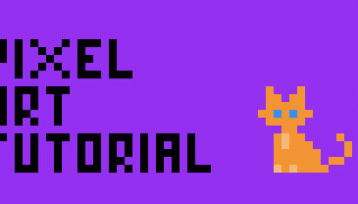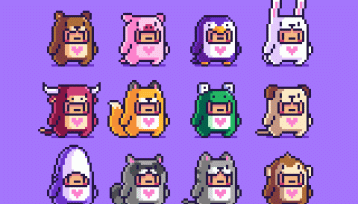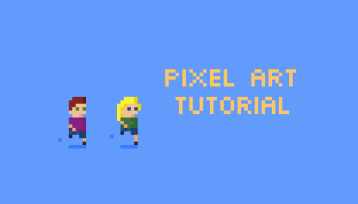Welcome to my beginner Pixel Art Tutorial – Farmyard goat post!
Hi everyone!
Since, ah, we’re all still working from home, it’s probably a good time to learn something new. We’re still looking to build up our little farm, so I thought a bouncing goat might be fun.
Here is what we’re making today…

I’ve been enjoying the twitter account Mayhem in Single Valley. Its art style is super cute, and while its way more sophisticated than pixel art, it’s definitely got that blocky pixel art look about it…
It looks kind of adorable… in a radioactive, post-apocolyptic way….

Here is a quick trailer if you’re interested:
I’m really digging the art style… here is a bunch of characters from the game…
… it’s super simple, but they convey a lot of character and action.
So, I’ve seen lots images from Mayhem in Single Valley and one was a bouncy goat… which we’re going to try and recreate here.
I’ll be using Pyxel Edit once again and I’ll also create a template that has 100 frames of 50×50 pixels for animation… but if you want to just create a single box of 50×50 pixels, that’s cool.

I’m very sure that we won’t need 100 frames, but I like to go way over than under, especially since it’s much easy to animate a bunch of different movements on the same sheet.
Alright, so this is our little goat:

I’ve added the grid in so you can easily see how many pixels all the sections are. This goat is bouncing around, and so this is him landing.
Here are the colours:

With pixel art, it’s so important to add shading in and slightly different colours to show depth. You can see the part of the body underneath the head is darker, to show it is the front/chest of the goat instead of the side (which is lighter).
Instead of building up this pixel art goat, I thought I’d instead show the animation steps. Here is the next part of the move…

The above move is the goat landing on the ground… his body is shorter and his muscles constrict ready to bounce again.

This move is the goat bouncing back up… parkour, parkour!

This is the goat mid-flight. The ears flap up to show the motion from the legs in the previous frame… it’s always important to have hair ears, tail etc to be on a slight delay to show movement.

This is the last frame, the little goat is heading towards the ground. He’s not landing yet, he’s doing that in the very first frame…
Okay… so 100 frames may have been overkill…


To begin animating this little parkour goat, click on the + button in the Animation section.
The default will animate 4 frames, but we have 5… so click on the Settings button to make some changes…

These are the default settings:

The name is the name of the animation… with the 100 frames I initially started with, I could add in bouncing, walking, eating, sleeping, anything really animations on the same page… and create separate animations for each. The cool thing about Pyxel Edit is that you can export just the animations… so you can throw everything on the same page (which really helps copy and paste components, and helps with spacing, etc), and select out the bits you really need.

I’ve changed the name to Bouncing. The Frame time multiplier is how quickly the frames run… I’ve changed it from 100% to 200% which means I’ve slowed it down to run at half the speed. I’ve also changed the Length to 5 to include all my 5 frames.

Click on File -> Export -> Export animation(s)…

Select a Pixel Scale of 8 and then Save.
This is what we’ve got… a little bouncy dude!

And then adding in #366e15 for a background… to make it more farmy…

His little beard fluff on his chin really comes alive with the green background…
Here’s what it looks like if I set the speed back to 100% and set the pixel scale to 4. Maybe it’s better? I think I might have just convinced myself…

The reason I created so many frames at the start was to give myself plenty of space to animate. The GIF at the very top of this post took up this many frames:

I really love having a lot of space to work with, especially since I’m still very new at figuring out movement and spacing.
It took me a while to figure out how much distance each movement would take up. I’m not sure I have it entirely right… but goats have kind of jerky movements where they spring into action.
I hope you’ve ended up with something similarly fun…

Thanks so much for reading this Pixel Art Tutorial – Farmyard goat post. If you’re excited about some pixel art action, please hit me up on Twitter…

Please note : The above post may contain affiliate links.
Below are some product referral links that I love and will benefit us both if you’re interested.
Splinterlands – A super fun blockchain card game that I play almost every day.
Fathom Analytics – Cookie notices no longer needed since Fathom doesn’t track data. You can see this site’s analytics right here.
Coil – A $5 USD monthly subscription fee provides you access to a ton of content and sites in a way that fairly rewards the creators of that content.
Exxp – The WordPress App to link your blog to the Hive blockchain.
NomadTask – Earn for completing online tasks like following accounts or completing reviews.
MINT Club – Create your own Smart Media Tokens with no coding required.
GALA Games – Gala is creating a whole platform of blockchain games. Definitely excited about Mirandus, Townstar and SpiderTanks.
MCO – Use my referral link https://crypto.com/app/9h9jnlxun9 to sign up for Crypto.com and we both get $25 USD.
Aptera – Get 30% off the reserve price for this incredible electric vehicle. (My post)









